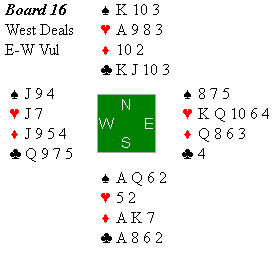And lost. Continue reading
The Rule of Nine, which was devised by Mel Colchamiro, is designed to aid in the decision as to whether to convert a low-level takeout double by one’s partner to penalty. One adds the following together:
- The number of cards in the opponent’s trump suit.
- The number of honors (tens count) in the opponent’s trump suit.
- The level of the bid.
If the total is nine or more, it is OK to pass. Note: overall strength is not a factor. The choice is between offense and defense.
South, not suriprisingly, doubled. Partner passed. Oh, that was a bad sign. He would have raised to three if he had three hearts. So, we had at most seven hearts. North paused to evaluate her hand for a few hours while I mentally enumerated the popes of the eleventh century so as not to give away my bluff. Alas, in the end North passed. I had no choice but to pass and take my medicine. This was the layout:
So, we had twelve points, and they had twenty-eight. I needed to hold it to down one unless the opponents had a rather freakish slam. Even at that, I had to hold it to down three. The first goal was obviously not possible unless they revoked two or three times while they were cashing their aces and kings, but I did manage to garner five tricks for -800.
North’s hand did not come close to meeting the Rule of Nine. Even if you change it to the Rule of Eight (because I only had five hearts), her hand fell short. So, Mel would predict that she made a big mistake in passing. Sure enough, North-South can make six spades or six clubs, and the play is not even that difficult. The only challenge is finding the ♣Q.
Unfortunately for me, no pair had the temerity to try the Moysian slam or the eight-card club slam. Nine played in 3NT, two played in 4♠, and one played in 3♣. Moreover, only one of the three who played in the black suits managed to bring home twelve tricks. So, it appeared that I made a big mistake by bidding.
However, that club bid intrigued me. The people who played there were pretty good players. I suspect that the person sitting in my chair at that table (the most aggressive bidder in the club) must have opened 2♥! [I found out later that he DID open 2♥.] If North followed the Rule of Nine, he would have probably bid clubs in response to his partner’s inevitable double. I would have. Playing lebensohl* he would probably bid 3♣. At that point South would either move to a club game or, if they were playing Western cue-bids, ask for a heart stopper. The latter approach would land them in 3NT.
If North-South was NOT playing lebensohl, what would North bid? Maybe he would venture 3♣, and South, armed with the knowledge that eleven tricks in a minor is always difficult, might just pass because she was afraid of the heart suit. Or maybe she would raise clubs. In either case they would not find the easy notrump game.
If so, then it was all or nothing. If North violated Mel’s rule and passed, East-West got a zero. If North bid, East-West won all the marbles.
So, was I chastened by this result? No, but in the future I might be a little more careful at unfavorable vulnerability.
* The lebensohl convention after a double of a weak two bid uses a relay from 2NT to 3♣ so that advancer can distinguish between weak hands and ones with at least seven points.

 I Fought the Rule of Nine
I Fought the Rule of Nine
